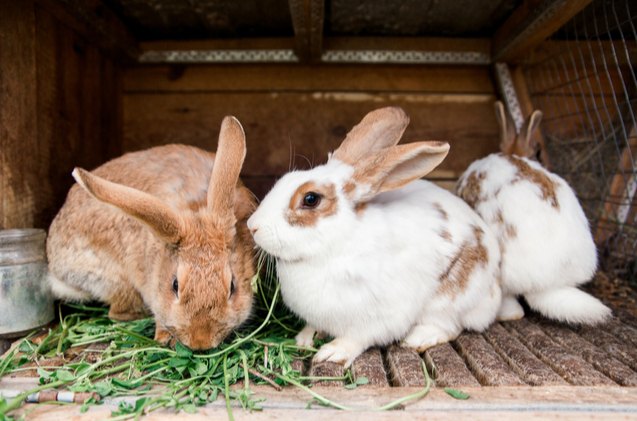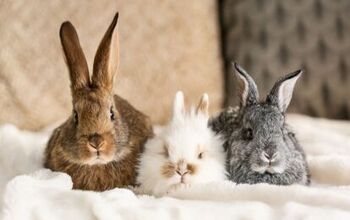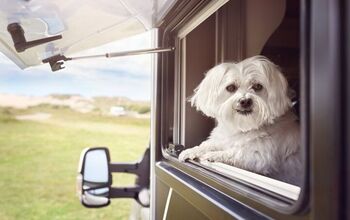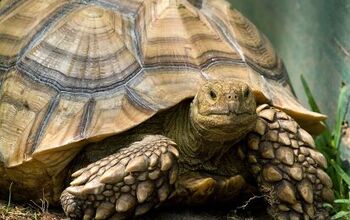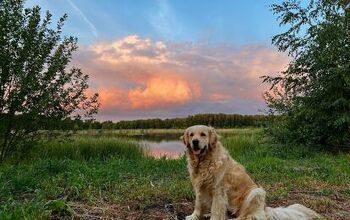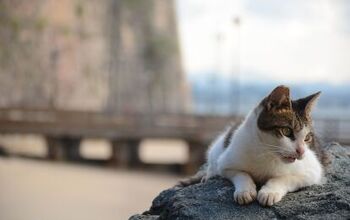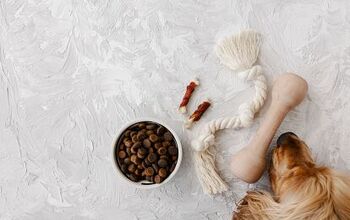10 Best Outdoor Rabbit Breeds

While most pet rabbits are meant to be kept indoors, there are a few rabbit breeds that are hardy enough to be housed outdoors. You might have an allergy, your dog doesn’t get along with your new pet, there’s not enough space in your home or something else entirely that makes it difficult to keep an indoor rabbit. Luckily, there are many hardy, adaptable bunnies that will not be endangered by living outside – provided that you take care of all their needs and make them appropriate outdoor housing. This will make sure that your rabbit is safe and happy while living in an outdoor enclosure, as the smallest mistakes (e.g. unsecured habitat) can cost your pet their health or even their life. But before we go over caring for an outdoor rabbit, let’s start with the best outdoor rabbit breeds so you can better choose your new companion.
#1 New Zealand White Rabbit
There are studies that describe cute and sweet New Zealand White rabbits as both heat and cold tolerant, which means that they adapt very well to outdoor living – as long as you provide them with proper shelter. Their short white fur is easy to groom, and they are docile and easy to handle, so they can be pets for any family, including those with kids. New Zealand white rabbits are very adaptable and make fantastic companions! Just have in mind that these are large breed rabbits that weigh 10 to 12 pounds and will need a larger hutch.
#2 Checkered Giant Rabbit
Sure, you’ll need to have plenty of space for an enclosure fit for a giant size breed, but their lovely personalities and cute looks are definitely worth sacrificing for! The Checkered Giant rabbit is an old rabbit breed and has been a popular pet rabbit for over 2 centuries, with good reason. They are best known for their unique markings, including a butterfly-shaped mark on the nose, contrasting ear colors, and stripes and dots across their body. As long as their outdoor hutch provides shelter from the elements and is spacious enough, they’ll be perfectly happy as outdoor pets. As they weigh 11 to 13 pounds, their enclosure needs to be at least 3ft x 3ft x 4ft
#3 Dutch Rabbit
The affectionate, gentle, and calm Dutch rabbit often tops the lists as one of the best rabbit breeds to keep as pets. However, they can adapt well to outdoor living, as long as they have plenty of space, shelter from the cold or the unbearable heat, and spend enough time outside of their enclosure. Their unique markings – dark-colored ears and rumps, a band of white from the top of their shoulders to their belly, and a “blaze” (white stripe running in front of their face – are their most defining trait apart from their personality. Classified as a small breed rabbit, these bunnies weigh 4.5 to 5.5 pounds on average.
#4 French Lop Rabbit
Those cute floppy ears are not just for the show – the longer ears enable rabbits to regulate their temperature. So it doesn’t surprise that a French Lop rabbit is one hardy breed that adapts well to outdoor living. Weighing 10 to 15 pounds on average, they are considered a giant breed, so make sure you make them a size-appropriate hutch for them to spend their time in. These rabbits come in a variety of colors, both solid and broken, so anyone can find a bunny that’s to their liking!
#5 Belgian Hare Rabbit
The exotic, wild looks of the Belgian Hare stem from the fact that the breed was created by crossing domestic breeds with wild rabbits – all the way back in the 18th century. These rabbits are distinct for their long muscular bodies with an arched back and a singular coat color which is best described as “bright tin rust with a reddish to orange tint”. Not surprisingly, Belgian Hares are often kept as show pets! As large size rabbits, they weigh 6 to 9 pounds.
#6 Californian Rabbit
From their mild temperament and friendly personality to their eye-catching looks, Californian rabbits are popular pets with good reason. Their white coat with dark markings is pretty distinct, so they are often displayed as show rabbits, but beloved as companions as well. These rabbits do quite well in an appropriate enclosure outside, but as large rabbits that weigh 8 to 10.5 on average, they do need a bit more space. But if you can spare some extra space to comfortably house a Californian, go for it – you’ll quickly fall in love with your new pet!
#7 Flemish Giant Rabbit
One of the most recognizable giant rabbit breeds, the Flemish Giant, is cherished for their wonderful personalities as well as their impressive size. They are often called the “gentle giants” of the bunny world and it’s true – they have a calm, affectionate, and mild temperament. As they are intelligent to boot, they make fantastic pets. In a proper outdoor enclosure and plenty of time out of it for exercise, these bunnies will thrive under your care. Weighing 9 to 14 pounds, with some Flemish Giants reaching a size over 20 pounds, these rabbits need very big enclosures, so have that in mind when considering adopting this breed.
#8 Rhinelander Rabbit
Whether it’s their beautiful looks or their great personality that got you interested in Rhinelander rabbits, it doesn't matter – these rabbits are fantastical through and through. Sporting a white coat with two different colored markings, they are a beautiful sight, and their friendly, patient and calm behavior make them great pets for first-time owners as they make fast friends and are easy to handle. As all rabbits that live outdoors, they too will need a safe, sheltered enclosure that allows them to thrive even though they are not housed inside. They weigh 6.5 to 10 pounds on average and are considered a large breed.
#9 Silver Fox Rabbit
Rare but stunning, the Silver Fox rabbit leaves no one indifferent. Their standing coat resembles that of an Arctic Silver Fox – hence the name, and they are even-tempered, friendly, and docile, which makes them one of the favorite breeds for the roles of companionship or show. They are large rabbits, with an average weight of 9 to 12 pounds, so they’ll need a large hutch where they can comfortably spend their time. Of course, some outside time for safe hopping around is a must, as well – so make sure you have enough space in your backyard to meet all of your rabbit’s needs!
#10 Fauve de Bourgogne
One of the oldest French breed rabbits, Fauve de Bourgogne can boast plenty of highly desirable traits. They are sweet, calm, docile, and easy to handle even if you are a first-time owner, and their unique russet red color definitely makes them one of the prettiest rabbit breeds around. What’s more, they are very hardy and adaptable and will do well when living outside, provided that they have an appropriate enclosure. They are a medium-sized breed with an average weight of 7 to 8 pounds.
How to Care for an Outdoor Rabbit
For most rabbits, the ideal living situation is sharing their home with their owner – living inside with them, whether in an enclosure or free-roaming the house. However, that’s not to say that it’s impossible to raise rabbits outdoors, as long as you provide a protective, spacious hutch for them to live in, away from heat and cold, and meet all of their other needs, such as a quality diet or safe space where they can play and explore the outdoors, outside of their enclosure.
Element-proof enclosure
If you plan on keeping a rabbit outdoors, the most important factor to consider is their enclosure. Rabbits are both in danger of predators as they are prey animals, and extreme weather – if it's too hot or too cold outside, they could be at risk for serious health issues. So first things first, their hutch should be predator-proof so no critter can find a way to your rabbit and they can’t get out unsupervised and expose themselves to predators. Next, you’ll want to be very careful about where you are placing their hutch. Ideally, it should be in the shade, in a spot that’s sheltered from harsh winds. Thanks to their fur, rabbits can do fairly well in the winter, but you might consider moving them into a shed or garage if the temperatures drop too low. The summer, however, isn’t a friend to rabbits. They are very prone to overheating and dehydration, which is why their hutch should be in a shaded location, with plenty of fresh water throughout the day and maybe even a cooling pad under their bedding to keep their body temperature better regulated.
The size of the enclosure will vary according to your rabbit size, but a good rule of thumb is that it should allow your bunny to make 3 hops comfortably, which can be significantly different for a Mini Lop or Flemish Giant rabbit. What’s more, most outdoor rabbits are kept in pairs or more, as outdoor rabbits need both the company and the warmth of another rabbit to keep them cozy when it’s cold outside. The hutch should be made from bunny-safe materials and be spacious enough to house one or multiple rabbits without making them feel cramped.
Quality diet
A rabbit’s diet is closely tied to their health – a lack of nutrients or an inadequate diet can severely endanger your pet’s health, often leading to fatal conditions. Rabbits eat primarily hay, usually timothy hay but any other grass hay is okay. This ensures that their dietary needs are met, but also helps with two very important things – preventing malocclusion and GI stasis. Rabbit’s teeth grow all throughout their life, and if they are not gently filed down with chew toys and eating hay on a daily basis, they can quickly become overgrown and cause health difficulties. On the other other hand, rabbits are avid at self-grooming, and swallowing hair can cause a fatal blockage in their intestines – the high fiber content in hay helps minimize that risk, but you should also groom your pet, minimizing the amount of hair they swallow in the first place. In addition to hay, you should also provide leafy greens and rabbit pellets on a daily basis to ensure they get all the nutrients that support their overall health and wellbeing.
Similarly, rabbits need fresh water at all times, so it’s imperative to frequently replace and replenish the water in their hutch. This is especially crucial in the summer when rabbits are at high risk for dehydration and overheating – plenty of water will help them stay hydrated and regulate their temperature better.
Treat them as a family pet
Even though your pet lives outside, it doesn’t mean that you should treat them any differently than you would if they were inside the house with you. Outdoor rabbits have the same needs as indoor rabbits! This means that you should spend lots of time with them and build your relationship, offer outside time in a safe dog pen or other outdoor enclosure where they can exercise and play, and provide them with the care they require. This means clean bedding (clean their hutch at least once a week), an appropriate diet, and regular vet checkups. Ideally, they’ll have the company of at least one other rabbit in their hutch, and you’d provide toys, chew toys, and other sources of entertainment for when you are not around to play and interact with your rabbit.

A proud mama to seven dogs and ten cats, Angela spends her days writing for her fellow pet parents and pampering her furballs, all of whom are rescues. When she's not gushing over her adorable cats or playing with her dogs, she can be found curled up with a good fantasy book.
More by Angela Vuckovic



